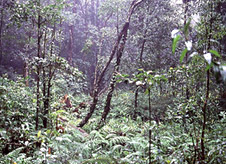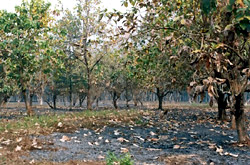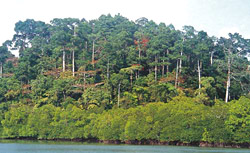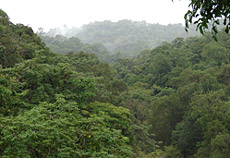 India`s unique topography, terrain, climate and vegetation, brings out natural diversity that cannot be witnessed anywhere else in the world. One such variation is also present in India`s wild-forested regions. Forests in India have always been one of the richest resources. Indian forests are ancient in nature and composition. India was once covered with dense forests. There is enough evidence to show this. The fact that they have existed for very long time is proved from the ancient texts all of which have some mention of the forests. The people honored the forests and a large number of religious ceremonies centered on trees and plants. The Agni Purana, written about 4000 years ago, stated that man should protect trees to have material gains and religious blessings. Around 2500 years ago, Gautama Buddha preached that man should plant a tree every five years. Sacred groves were marked around the temples where certain rules and regulations applied.
India`s unique topography, terrain, climate and vegetation, brings out natural diversity that cannot be witnessed anywhere else in the world. One such variation is also present in India`s wild-forested regions. Forests in India have always been one of the richest resources. Indian forests are ancient in nature and composition. India was once covered with dense forests. There is enough evidence to show this. The fact that they have existed for very long time is proved from the ancient texts all of which have some mention of the forests. The people honored the forests and a large number of religious ceremonies centered on trees and plants. The Agni Purana, written about 4000 years ago, stated that man should protect trees to have material gains and religious blessings. Around 2500 years ago, Gautama Buddha preached that man should plant a tree every five years. Sacred groves were marked around the temples where certain rules and regulations applied.
It was Chandra Gupta Maurya who came to power around 300 B.C and realized the importance of forests. Therefore he appointed a high officer to look after the forests. Ashoka stated that wild animals and forests should be preserved and protected. He launched programmes to plant trees on a large scale. These rules continued even during the Gupta period. The forests acted as a refuge to people during the Musilm rule. People fled from their home and took refuge in these forests. The Muslim invaders were all very keen hunters and therefore it was necessary for them to have patches of forests where they could go hunting. This ensured that the trees in these hunting areas were not felled, and the forest ecology was not tampered with. The Mughals showed more interest in gardens and their development. Akbar ordered the planting of trees in various parts of his kingdom whereas Jahangir was well known for laying out beautiful gardens and planting trees.
Then came the British period. During the early part of the British rule, trees were felled without any thought. Large numbers of trees such as the sal, teak, and sandalwood were cut for export. The British gradually started using these forests as a resource for revenue generation. They made a rule in which the trees could not be felled without prior permission, and this in turn made them the sole owner and users of the valuable Indian forests. These forests were the richest resources for the British colonies.
The importance of having forests was later realized, around the 1800`s, when a commissioner was appointed to look into the availability of teak in the Malabar forests. In 1806, the Madras government appointed Capt. Watson as the commissioner of forests for organizing the production of teak and other timber suitable for the building of ships. Forest management was primarily aimed at the production of commercial products such as teak timber. The post of a conservationist was created and this term was related to the patches of forests that they managed, called conservancies, and was not related to biodiversity conservation. Even today, vast tracts of Indian forests are covered with teak plantations, low in biodiversity and seasonally ravaged by forest fires. The first foresters in India were highly influenced by forest management in Germany and many forest officers in India were trained in the German school of thought brought into India by Dietrich Brandis (1824-1907)-the father of tropical forestry.
In 1855, Lord Dalhousie framed regulations for conservation of forest in the entire country. Teak plantations were raised in the Malabar hills and acacia and eucalyptus in the Niligiri Hills. From 1865 to 1894, forest reserves were established to secure material for imperial needs. From the 18th century, scientific forest management systems were employed to regenerate and harvest the forest to make it sustainable.
 Another area of interest was the introduction of plants of economic importance to India. Many of these introductions were tried in botanical gardens at Sibpur, Poona, Madras and Saharanpur. The Chinese monopoly on tea was ended when tea was introduced in Darjeeling and Sri Lanka. The botanical garden at Sibpur in Calcutta was started in 1787 by Col. Robert Kyd (1746-1793). Sir George King (1840-1904) who was in charge of the garden from 1871 was instrumental in the creation of a herbarium at the garden and founded the Botanical Survey of India in 1890. Later botanical workers include the paleobotanist Birbal Sahni (1891-1949). During World War I forest resources were severely depleted as large quantities of timber were removed to build ships and railway sleepers and to pay for Britain`s war efforts. Between the two wars, great advancements in scientific management of the forests were made, with many areas undergoing regeneration and sustained harvest plans being drawn up.
Another area of interest was the introduction of plants of economic importance to India. Many of these introductions were tried in botanical gardens at Sibpur, Poona, Madras and Saharanpur. The Chinese monopoly on tea was ended when tea was introduced in Darjeeling and Sri Lanka. The botanical garden at Sibpur in Calcutta was started in 1787 by Col. Robert Kyd (1746-1793). Sir George King (1840-1904) who was in charge of the garden from 1871 was instrumental in the creation of a herbarium at the garden and founded the Botanical Survey of India in 1890. Later botanical workers include the paleobotanist Birbal Sahni (1891-1949). During World War I forest resources were severely depleted as large quantities of timber were removed to build ships and railway sleepers and to pay for Britain`s war efforts. Between the two wars, great advancements in scientific management of the forests were made, with many areas undergoing regeneration and sustained harvest plans being drawn up.
A great upheaval in the Forestry organization in India came with the independence of India in 1947. The princely states were managed variably, giving more concessions to the local populations. The transfer of these states to the government led to deforestation in these areas.
The new Forest Policy of 1952 recognized the protective functions of the forest and aimed at maintaining one-third of India`s land area under forest. Certain activities were banned and grazing restricted. In 1976, the governance of the forest came under the concurrent list. `Development without destruction` and `forests for survival` were the themes of the next two five-year plans, aiming at increasing wildlife reserves and at linking forest development with the tribal economy. Conservation has been an avowed goal of Indian government policy since Indian independence. Afforestation increased from a negligible amount in the first plan to nearly 8.9 million hectares in the seventh plan. But a large gap between aim and achievement still exists.
 In the early 1990`s about 17 percent of India`s land was regarded as forestland. However, because more than 50 percent of this land was barren or brush land, the area under productive forest was actually less than 35 million hectares, or approximately 10 percent of the country`s land area. The growing population`s high demand for forest resources continued the destruction and degradation of forests through the 1980s, taking a heavy toll on the soil. Many Indian forests in the mid-1990s are found in high-rainfall, high-altitude regions, areas to which access is difficult. About 20 percent of total forestland is in Madhya Pradesh; other states with significant forests are Orissa, Maharashtra, and Andhra Pradesh (each with about 9 percent of the national total); Arunachal Pradesh (7 percent); and Uttar Pradesh (6 percent). The variety of forest vegetation is large: there are 600 species of hardwoods, sal (Shorea robusta ) and teak being the principal economic species.
In the early 1990`s about 17 percent of India`s land was regarded as forestland. However, because more than 50 percent of this land was barren or brush land, the area under productive forest was actually less than 35 million hectares, or approximately 10 percent of the country`s land area. The growing population`s high demand for forest resources continued the destruction and degradation of forests through the 1980s, taking a heavy toll on the soil. Many Indian forests in the mid-1990s are found in high-rainfall, high-altitude regions, areas to which access is difficult. About 20 percent of total forestland is in Madhya Pradesh; other states with significant forests are Orissa, Maharashtra, and Andhra Pradesh (each with about 9 percent of the national total); Arunachal Pradesh (7 percent); and Uttar Pradesh (6 percent). The variety of forest vegetation is large: there are 600 species of hardwoods, sal (Shorea robusta ) and teak being the principal economic species.
India`s long-term strategy for forestry development reflects three major objectives:
•to reduce soil erosion and flooding;
•to supply the growing needs of the domestic wood products industries; and
•to supply the needs of the rural population for fuel wood, fodder, small timber, and miscellaneous forest produce.
To achieve these objectives, the National Commission on Agriculture in 1976 recommended the reorganization of state forestry departments and advocated the concept of social forestry. The commission itself worked on the first two objectives, emphasizing traditional forestry and wildlife activities; in pursuit of the third objective, the commission recommended the establishment of a new kind of unit to develop community forests. Following the leads of Gujarat and Uttar Pradesh, a number of other states also established community-based forestry agencies that emphasized programs on farm forestry, timber management, extension forestry, reforestation of degraded forests, and use of forests for recreational purposes. The State community forestry agencies emphasized such projects. Both individual farmers and tribal communities were also encouraged to grow trees for profit. For example, in Gujarat, one of the more aggressive states in developing programs of socioeconomic importance, the forestry department distributed 200 million tree seedlings in 1983. The fast-growing eucalyptus is the main species being planted nationwide, followed by pine and poplar.
The National Forest Policy of 1988 further emphasized on the role of India`s forests in the National economy and ecology. It focused on ensuring environmental stability, restoring the ecological balance, and preserving the remaining forests. Also in 1988, the Forest Conservation Act of 1980 was amended to facilitate stricter conservation measures. A new target was to increase the forest cover to 33 percent of India`s land area from the then-official estimate of 23 percent.
Better late than never- people have realized that deforestation threatened not only the ecology but also their livelihood in a variety of ways. Thus, people have become more interested and involved in conservation. The Chipko movement in India was the best-known popular activist movement, wherein local women decided to fight the government and the vested interests to save trees. This movement took place in Uttar Pradesh where women literally `stuck to` or `chipko` to the trees, and would not let the manufacturers cut them down. This movement has spread and become an ecological movement leading to similar actions in other forest areas. The movement has slowed down the process of deforestation, exposed vested interests, increased ecological awareness, and demonstrated the viability of people power.
 India possesses a distinct identity, not only because of its geography, history and culture but also because of the great diversity of its natural ecosystems. The panorama of Indian forests ranges from evergreen tropical rain forests in the Andaman and Nicobar Islands, the Western Ghats, and the northeastern states, to dry alpine scrub high in the Himalaya to the north. Between the two extremes, the country has semi-evergreen rain forests, deciduous monsoon forests, thorn forests, and subtropical pine forests in the lower montane zone and temperate montane forests. The Andaman and Nicobar Island islands have tropical evergreen rain forests and tropical semi-evergreen rainforests as well as tropical monsoon moist monsoon forests.
India possesses a distinct identity, not only because of its geography, history and culture but also because of the great diversity of its natural ecosystems. The panorama of Indian forests ranges from evergreen tropical rain forests in the Andaman and Nicobar Islands, the Western Ghats, and the northeastern states, to dry alpine scrub high in the Himalaya to the north. Between the two extremes, the country has semi-evergreen rain forests, deciduous monsoon forests, thorn forests, and subtropical pine forests in the lower montane zone and temperate montane forests. The Andaman and Nicobar Island islands have tropical evergreen rain forests and tropical semi-evergreen rainforests as well as tropical monsoon moist monsoon forests.
The Indian forest type recognizes 16 major types of forests, subdivided into 221 minor types. Structure, physiognomy and floristic are all used as characters to define the types. The main areas of tropical forest are found in the Andaman and Nicobar Islands; the Western Ghats, which fringe the Arabian Sea coastline of peninsular India; and the greater Assam region in the north-east. Small remnants of rain forest are found in Orissa state. Semi-evergreen rain forest is more extensive than the evergreen formation partly because evergreen forests tend to degrade to semi-evergreen with human interference.
 Western Ghats Monsoon forests" border="1">The Western Ghats Monsoon forests occur both on the western (coastal) margins of the ghats and on the eastern side where there is less rainfall. These forests contain several tree species of great commercial significance, e.g. Indian rosewood Dalbergia latifolia, Malabar Kino Pterocarpus marsupium, teak and Terminalia crenulata. Clumps of bamboo occur along streams or in poorly drained hollows throughout the evergreen and semi-evergreen forests of southwest India, probably in areas once cleared for shifting agriculture.
Western Ghats Monsoon forests" border="1">The Western Ghats Monsoon forests occur both on the western (coastal) margins of the ghats and on the eastern side where there is less rainfall. These forests contain several tree species of great commercial significance, e.g. Indian rosewood Dalbergia latifolia, Malabar Kino Pterocarpus marsupium, teak and Terminalia crenulata. Clumps of bamboo occur along streams or in poorly drained hollows throughout the evergreen and semi-evergreen forests of southwest India, probably in areas once cleared for shifting agriculture.
The tropical vegetation of northeast India, which includes the states of Assam, Nagaland, Manipur, Mizoram, Tripura and Meghalaya as well as the plain regions of Arunachal Pradesh embraces evergreen and semi-evergreen rain forests, moist deciduous monsoon forests, riparian forests, swamps and grasslands. Evergreen rain forests are found in the Assam Valley, the foothills of the eastern Himalayas and the lower parts of the Naga Hills, Meghalaya, Mizoram, and Manipur where the rainfall exceeds 2300 mm per annum.
Central Indian forests has been defined by Birdlife International as a Secondary Area for bird endemism, as it includes the range of the critically endangered Forest Owlet. It includes the southern region of Madhya Pradesh, the Vidarbha region of Maharastra and Chattisgarh. This forest is of Dry Decidous type, i.e, the trees shed their leaves in the summer season. Many Wildlife Sanctuaries and National Parks are housed in these forests. Some of them are Kanha National Park, Pench National Park and Melghat wildlife sanctuary. The Forest Owlet was thought to be extinct but was rediscovered in Melghat.
A communal forest in India is a specific term which refers to forests governed by local communities in a way compatible with sustainable development, and can be of various types. Such forests are typically called village forests or panchayat forests, reflecting the fact that the administration and resource utilization of the forest occurs at the village and panchayat level, which is an elected rural body. Such community forests are usually administered by a locally elected body, usually called the Forest Protection Committee, Village Forest Committee or the Village Forest Institution. Such committees are known as Van Panchayats in the Kumaon Division of Uttarakhand, Forest Co-operative Societies in Himachal Pradesh and Van Samrakshan Samitis in Andhra Pradesh.






